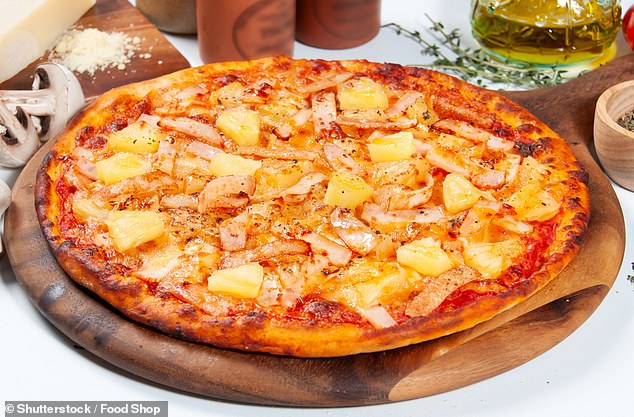From olives to ham, to egg and the controversial pineapple, there’s never a shortage of toppings to choose from when we order a pizza.
What exactly you opt for might feel like a spur-of-the-moment decision – but it may reveal unexpected traits about your personality.
A scientist has revealed what your favourite pizza toppings say about you – and it’s bad news for people who go for pineapple.
Dr Alan Hirsch, director of the Smell & Taste Treatment and Research Foundation in Chicago, says food preferences reveal a lot about personality type.
And when in a social situation, such as a date, we can size up another person based on their pizza toppings.
‘Often when you order pizza, you choose the same one over and over again,’ Dr Hirsch told the Daily Mail.
‘You’re choosing to eat pizza not for its nutritional value, but based on what your personality is like.
‘If you go on a date with someone, you can see what pizza they order to work out their personality, and help you decide if you want to go on another date.’

Revealed: What your favourite pizza toppings say about you, according to science – and it’s bad news for people who love pineapple
Dr Hirsch’s experiments recruited 1,000 American adults who completed personality tests while noting their pizza-eating habits, including preferred toppings.
And the results revealed some intriguing findings that may dictate the ways in which people interact with each other.
Those who prefer a traditional single meat on pizza – such as pepperoni or ham – tend to be irritable and argumentative, resentful of other people and with a tendency to procrastinate, it found.
Meanwhile, people who go mad with a meat feast – typically featuring many different meat options – are dramatic, seductive extroverts who love being centre of attention.
On the other hand, those opting for vegetables on pizza are empathetic, easygoing, understanding, and well-adjusted, making them ‘universal romantics’ and ideal parents.
Diners who have a penchant for spicy options such as jalapeño chillis tend to be a ‘risk-takers’ who like the associated adrenaline rush that comes with it.
Meanwhile, those people who opt for a lot of nutritional protein – such as chicken and seafood – are often more sociable or outgoing.
But those who order non-traditional toppings such as pineapple and onion tend to be aggressive and achievement-oriented, not willing to suffer fools gladly.

Those who prefer a traditional single meat on pizza – such as pepperoni or ham – tend to be irritable and argumentative, resentful of other people and with a tendency to procrastinate

Those who prefer traditional vegetables toppings are empathetic, understanding, well adjusted and easy going, according to the study
Dr Hirsch stressed that his study found a correlation rather than causation between personality and chosen pizza toppings.
In other words, it’s unknown if personality causes us to choose certain pizza toppings (or in fact if our choice of pizza toppings affects our personality).
A spokesperson for British pizza chain Fireaway said pepperoni fans ‘always bring the energy at parties’, while chili fans ‘thrive in emotional thunderstorms’.
Meanwhile, mushroom lovers are ‘complex’ and ‘earthy’, but those who choose pineapple are ‘agents of chaos’ who ‘flirt with danger’, they told the Daily Mail.
And those who go for olives, either green or black, have a ‘Marmite personality’ that others either ‘adore or absolutely cannot stand’.
Fireaway’s data across more than 160 of its stores and delivery platforms over the last six months reveal the top 10 toppings picked by customers.
They are pepperoni, chicken, jalapeño chilli, red onion, mushrooms, vegan cheese, pineapple, sweetcorn, beef meatballs and olives.
According to 2017 research by YouGov, mushroom is the UK’s most-liked pizza topping – beating several classic meaty elements.

Diners who have a penchant for spicy options such as jalapeño chillis tend to be a ‘risk-takers’ who like the associated adrenaline rush that comes with it

In 2017, YouGov asked Brits which toppings they like on their pizza. Mushroom was cited by 65 per cent of respondents, more than any other item
When polled, 65 per cent of over 3,600 British adults said mushroom would be on their ideal pizza, followed by 62 per cent for onions and 61 per cent for ham.
Less important elements were peppers (named by 60 per cent), pepperoni (56 per cent), chicken (56 per cent), tomatoes (51 per cent), bacon (49 per cent), pineapple (42 per cent) and sweetcorn (42 per cent).
Sweetcorn, Dr Hirsch told the Daily Mail, is not a popular option on pizza in the US, not to mention in Chicago, where the ‘deep dish’ is traditionally served.
Controversially, YouGov’s research also found 53 per cent of respondents like pineapple on their pizza, 41 per cent do not, and 6 per cent don’t know.
It was back in 2017 that the President of Iceland sparked a global debate when it emerged that he wanted to ban pineapple as a topping on pizza.
Guðni Thorlacius Jóhannesson was later forced to clarify that a pineapple topping ban was merely a personal desire and not a policy objective.









